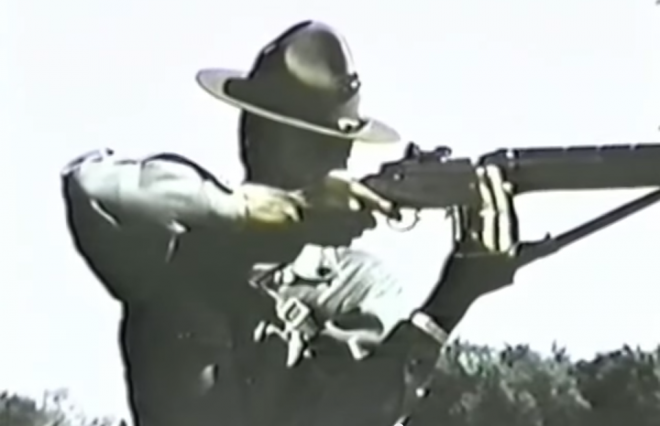In my ongoing research effort on the 20th Century infantry rifle, I found an interesting training film from the 1960s. The USMC video is not quite 22 minutes in length, and covers marksmanship instruction on the M14 rifle:
The film teaches very traditional techniques – those demonstrating the rifle use traditional shooting stances, shooting gloves, and are shooting at bullseye targets at known ranges. The rifle and instruction both seem suited to static range shooting – the rifle’s sights dial in MOA increments, and one suggestion for windage estimate is to stand up and drop a piece of paper – not ideal solutions for combat, but great for the static range. Interestingly, what’s now derisively called the “chicken wing” is taught in the video as good technique. The M14 rifle is also described as being “easily convertible to full auto”, which nods to the practice of issuing M14 rifles with “buttons” in place of selectors. The rifles, though they lacked selectors, were otherwise fully functional automatic weapons, and needed only to have the “button” replaced with a selector to become an automatic rifle.
This sort of shooting was pioneered in the National Matches, and while it’s certainly superior to what came before it, it has proven less than realistic in modern infantry combat. As a result military training has changed – although sometimes achingly slowly – away from the kinds of techniques shown in the video. Another video, this one from 1999, helps illustrate the transition, although the differences can be subtle:
The absolute fundamentals – sight picture, trigger control, breathing, follow through, achieve much greater emphasis – dominating the video, while the traditional marksmanship positions are left out. The targets, too, have changed: What was then a bullseye has become a reduced “bust” silhouette, at which the trainees are instructed to shoot center of mass. Some more practical details – eye relief, shooting while wearing glasses, and forcing a respiratory pause have been added. Interestingly, the video does not include any instruction on sighting in the rifle or adjusting it. It’s possible that was taught in a separate video, or by an instructional lesson; presumably it would still be considered essential knowledge for the Marine infantryman in 1999.
For National Match competition – or even a casual day at the range – I would probably recommend the first video. The second, however, I believe is a more realistic training video for the infantryman. The traditional shooting positions that are more practical on the range than on the battlefield are still represented, but not so heavily emphasized. Instead, the absolute basics are reinforced more.
Even the 1999 video is dated. Since then, there have been two major wars and a whole body of experience on how to fight that has been refined. Shouldering the rifle while wearing body armor, using optics, and the abandonment of “one round, one target” mentality are just three major improvements that have been applied in the past few years.
H/T, LooseRounds and Historical Firearms
 Your Privacy Choices
Your Privacy Choices
